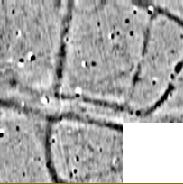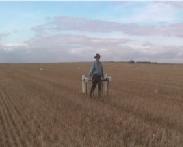|
FM256 Fluxgate Gradiometer
The FM256 instrument can be used in either scanning mode, to search rapidly for disturbed areas, or in logging mode, where detailed data are collected in parallel or zig-zag traverses. The data-logging facilities, with integral sample trigger, provide powerful functions for fast and efficient surveying, keeping track of survey position, and giving both audible and visual indication of current survey position. Data can be collected at up to 16 samples/m and stored in a 256000 reading memory.
Readings are displayed on an LCD display in either digital or analogue bar-graph form, the latter being useful for scanning. Backlight control for the LCD display enables work to continue in poor light conditions or short winter days; contrast adjustment improves visibility over temperature extremes. A Real Time clock facility is included which can be used to monitor progress since wristwatches are too magnetic for operators to wear. A Hold facility, which freezes the reading, is provided to allow easy sensor balancing. Although not often required, owing to the excellent stability of the instrument, any change in the instrument zero may be logged at the end of each grid and used to correct for drift. Geoplot software has standard processing routines that usually make drift correction logging unnecessary.
Cost effective upgrade routes allow existing FM18 and FM36 users to convert their instruments to FM256 specifications.
DATA LOGGER
Readings are logged in a 256000 reading non-volatile memory which may be partitioned into square or rectangular grids with dimensions of 10, 20, 30, 40, 50 or 100m - typically these are 20m or 30m square grids. The wide range of grid sizes allows you to tailor logging to your survey requirements. Sample and traverse intervals can be set to 1, 2, 4, 8 or 16 samples per metre, with 16 samples giving maximum resolution. The data logger keeps track of survey position, displaying the current grid, line and position and provides audio feedback. Instead of menu systems, the front panel has been designed to provide fast and direct access to logging functions using 8 dedicated keys. Readings and lines of readings taken by mistake can be deleted with one keystroke. A dummy reading can be inserted if a physical obstacle prevents a true reading being taken or a line may be completed with dummy readings, again with one keystroke. In zig-zag surveying these "Finish Line" dummy readings can be imaged with one keystroke - see keypad layout opposite. The 256000 reading memory is sufficient for 35 x 30m x 30m grids at 8 samples/m or 80 x 20m x 20m grids at 8 samples/m (about 3 hectares), allowing a full days data collection with no data transfer. Data is downloaded to a PC via an RS232 interface, typically into Geoplot or any other suitable program. Downloading the full 256000 readings takes as little as 15 minutes, depending on the output format chosen - 5 are provided. Logged data can be inspected without having to download first, allowing the user to monitor data quality as the survey proceeds.
SAMPLE TRIGGER OR MANUAL LOGGING
Data logging is usually performed under control of an integral sample trigger but can also be done manually, one reading at a time. Logging is usually performed using the start/stop switch or the keypad. If preferred, an external hand-log key is available for manual or sample trigger logging. Sample trigger logging provides increased data sampling and enhances data quality and interpretation without increase in survey time. Pressing the start/stop switch initiates a sequence of "beeps" that sound every metre whilst internally the gradiometer logs readings at the set sample interval. The operator walks along the survey line at a pace that ensures the "beeps" coincide with 1m marks along the tape - with practice the tape can be dispensed with for even faster surveys. The "beep" rate is variable between 0.4s and 3.0s, in 0.02s steps. Data can be logged at 8 samples/m at an average rate of 0.8s/m or faster, according to site. If a reading goes over-range, this is recorded in the data and is distinguishable from dummy readings. Both manual and sample trigger logging can operate in the digital averaging mode for improved data quality.
DIGITAL AVERAGING
The FM256 automatically integrates the readings at all times so as to minimise system noise. Digital averaging can be selected to improve further the signal to noise ratio, useful on sites where anomaly strength is comparable with system noise. A wide range of averaging cycles (2 to 32), allows the user to optimise the trade off between significant noise reduction and optimum speed. Digital averaging is automatically used when Zeroing and using Log Zero Drift for improved accuracy.
POWER SYSTEM
The FM256 is powered by 2 "C" sized cells, either a NiMH battery pack with temperature sensor or 2 standard alkaline cells mounted in the holder provided. The instrument operating period with NiMH cells is 21 hours without LCD backlight, 15 hours with LCD backlight (44 hours and 31 hours respectively for alkaline cells). The NiMH cells can be fast charged in 4 hours from the universal voltage power supply which is supplied with worldwide pin adapters (the charging circuit prevents accidental charging of alkaline cells). Charging status (fast or trickle) is shown by a dual colour LED. Operation from standard alkaline cells allows operation in remote locations with no charging facilities. A separate, easily obtained, lithium battery is used to backup the non-volatile memory for up to 10 years. The main and backup batteries are housed under the instrument housing in two separate sealed compartments with external access, making battery changes simple. This preserves environmental seals and isolates any alkaline battery leakage.
PRACTICALITY AND DESIGN
The FM256 builds upon the rugged and reliable design of its predecessor, the FM36, making it an instrument that can be used in a diverse range of demanding environments, such as harsh desert conditions, the tumbles of student field courses, time critical commercial surveys and peace time military environments. The design retains the proven benefits of a 0.5m sensor separation which gives good mobility, good ground clearance and the option to carry the instrument higher above the ground. This flexibility allows it to operate in scrubland, brushwood, long grass and in other overgrown areas, where other sensor systems operating nearer the ground may be difficult to use. The use of a short tube means it is much less prone to buffeting by the wind which can introduce significant measurement errors. A 0.5m sensor separation provides good rejection of signals from nearby ferrous clutter such as iron or barbed wire fences allowing you to survey close to such interference.
The versatile and ergonomic design incorporates many features requested by FM36 users, provides an economic upgrade route for existing FM18 / FM36 users and can be expanded into a dual gradiometer system. Environmental sealing to IP65 standard or better is used and a gold connector system is used internally for maximum reliability, especially in higher humidity climates. A rugged tube is used to support the fluxgate sensors which are housed in a robust outer case. A geared alignment system provides excellent stability and very fine control when aligning the sensors for optimum performance.
|
|











